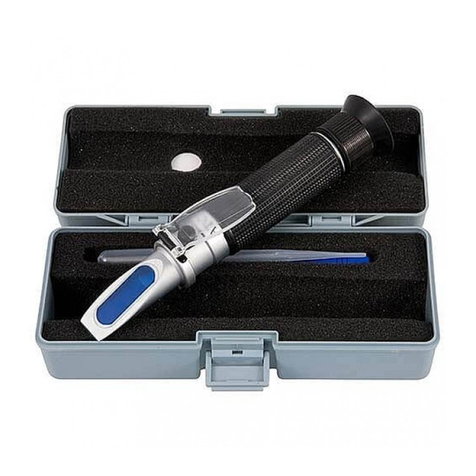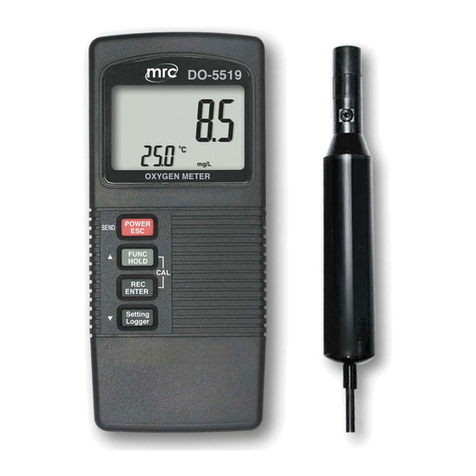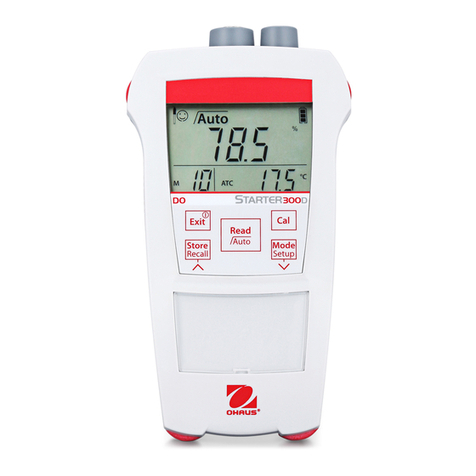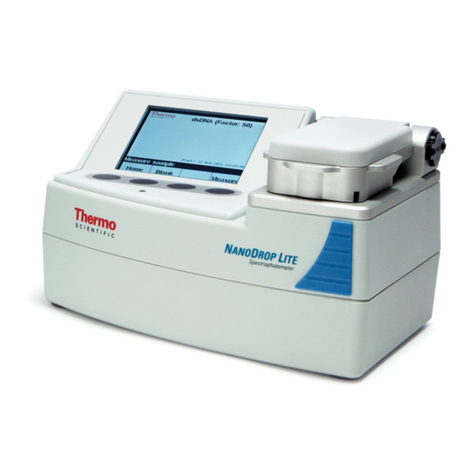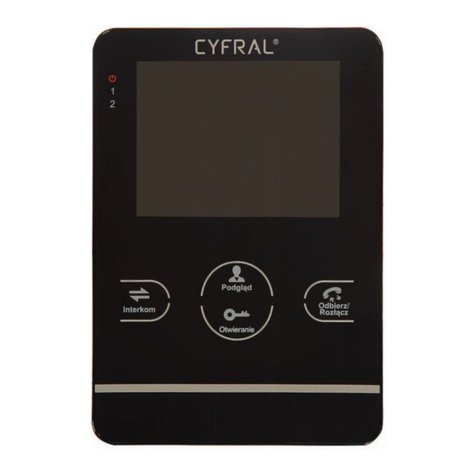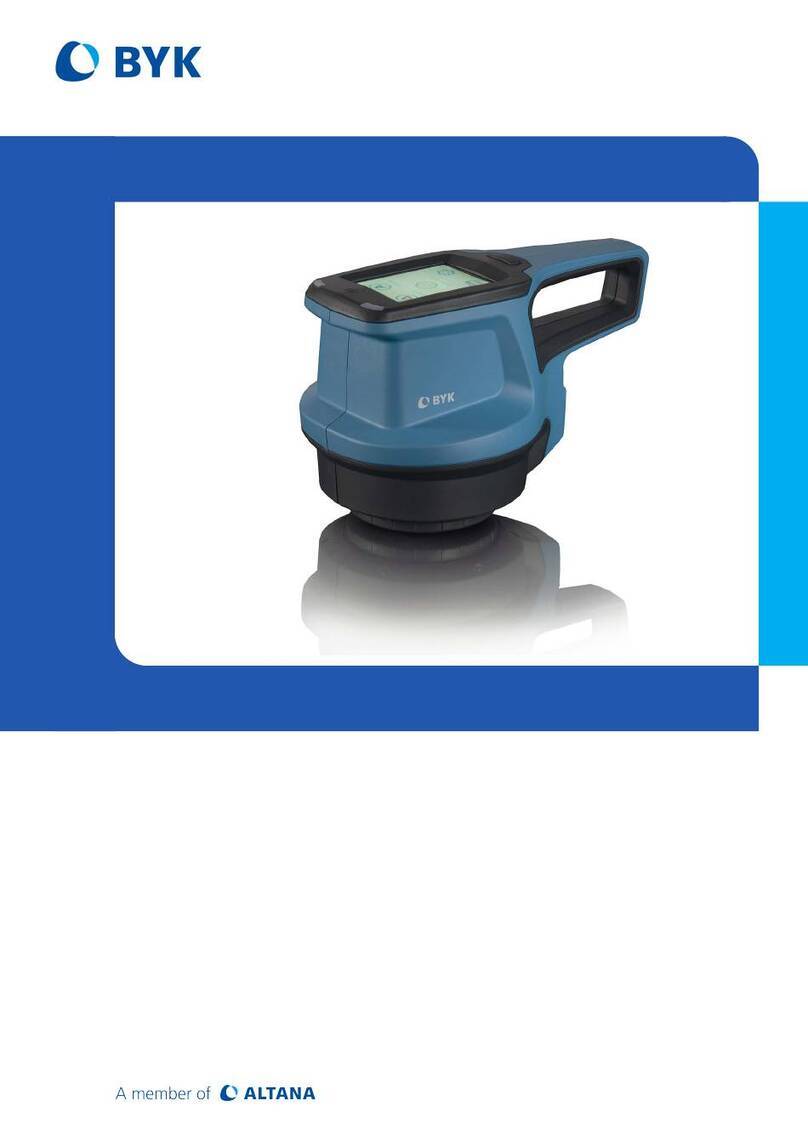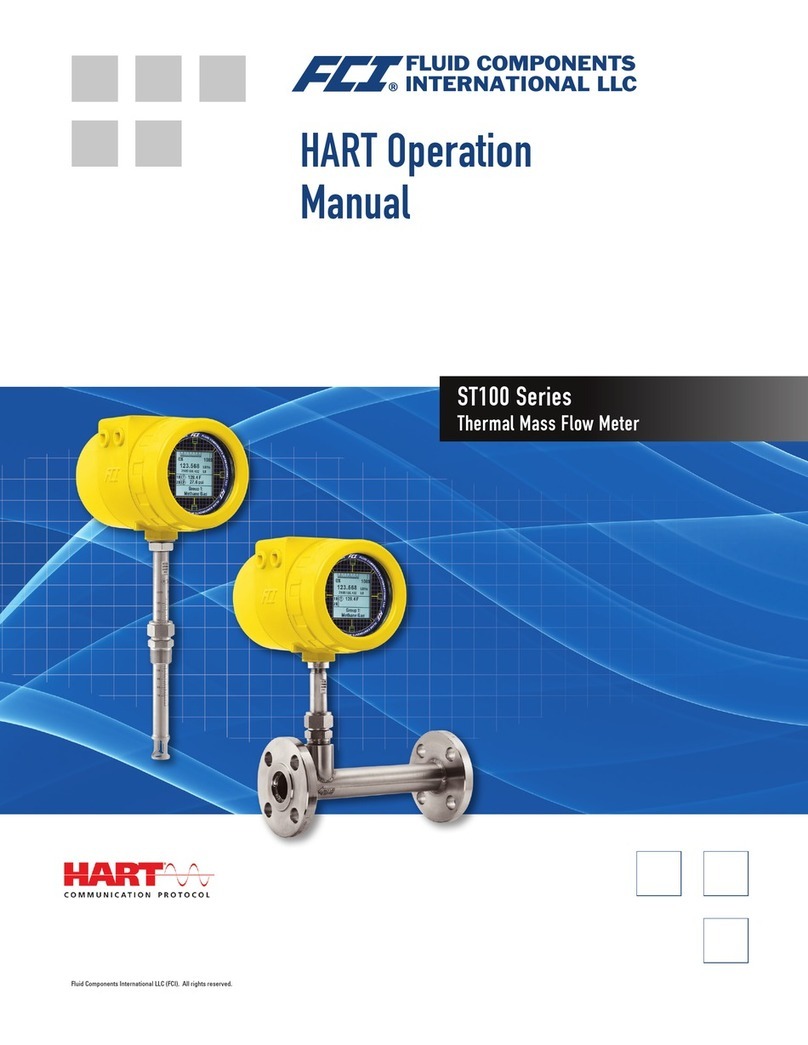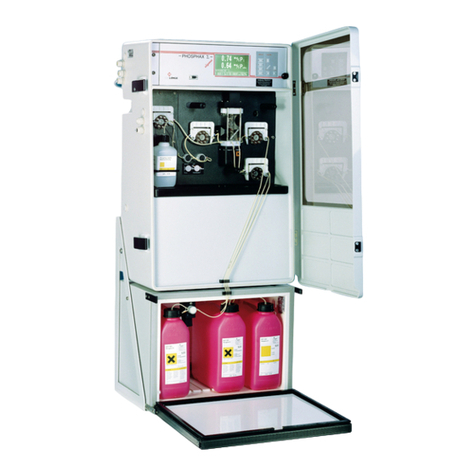PCE Group PCE-WMH3 User manual

Manual
Wood Moisturemeter
PCE-WMH3
www.pce-group-europe.com
PCE Deutschland GmbH & Co KG
Im Langel 4
Deutschland
D-59872 Meschede
Tel: 029 03 976 99-0
Fax: 029 03 976 99-29
www.pce-group-europe.com

- 10 -
This warranty becomes null and void if you fail to pack your
PCE-WMH3 in a manner consistent with the original product
packaging and damage occurs during product shipment.
This warranty does not cover: circumstance beyond our
company’s control; service required as the result of unauthorized
modifications or service; misuse, abuse; failure to follow our
company operating or maintenance instructions.
Repair or replacement without charge is our company’s only
obligation under this warranty. Our company will not be
responsible for any special, consequential or incidental damages
resulting from the purchase, use, or improper functioning of this
equipment regardless of the cause. Such damages for which our
company’s will not be responsible include, but are not limited to,
loss of revenue or profit, downtime costs, loss of use of the
equipment, cost of any substitute equipment, facilities of services,
or claims of your customers for such damages.
Important
We recommend to prevent faulty result in measurements
please check your meter reading results within a adequate time
period by the dry oven test according DIN 52 183 Standard.
- 3 -
4. PREPARING THE INSTRUMENT
Use the ”WOOD TYPE” button to select the appropriate wood
type group and the “WOOD TEMP.” button to set the wood
temperature. The temperature setting step is 2°C. Pressing and
holding the “WOOD TEMP.” button “fast forwards” the setting.
This can be used to quickly change the temperature setting e.g.
from -10°C to 40°C.
The most common European wood types are listed in a table
on the instrument.
All exotic wood types (270 species) listed in the users manual
(page 6 and next) are divided into 4 groups. During measurements
of moisture contents of exotic wood types the “WOOD TYPE”
should be set to:
- Group 1 - select 1
- Group 2 - select 2
- Group 3 - select 3
- Group 4 - select 4
5. SELECTING NEEDLES
We recommend that the length of the needles you use should
be about 25-30 % of the thickness of the timber. With this length
of needles the device displays the average moisture contents.
6. THE MEASUREMENT
To conduct measurements:
- press and hold for a while the “ON/OFF” button to turn the
instrument on,
- hammer the instrument into the wood, a line drawn between
the needles should be perpendicular to the fibers (the resis-
tance should be measured across the fibers),
- the strength used for hitting the wood should be appropriate to
the hardness of the wood, do not use excess force, hitting the
wood with the body of the device (when the needles have been
completely inserted into the wood) may damage the device,
- wait until the result stabilizes,
-read the result on the LCD,
- the instrument can be turned off by pressing and holding the
“ON/OFF” button or it will turn off automatically after
approx. 5 minutes.

- 8 -
Gruop 3 cont. (set “WOOD TYPE” to 3)
Birch, yellow
Birch, meanness
Blackwood, afr.
Blackwood, austr.
Blue Gum
Bomax
Borneo
Camphorwood
Brushbox
Bruyere
Boire
Cabbage-bark, black
Campeche
Campherwood, real
Campherwood, afr.
Canarium, afr.
Cativo
Chengal
Cherry
Chickrassy
Cocobolo
Coigue
Cypresse
Daniellia
Danta
Diambi
Douka
Elm
Esia
Eucalyptus
Europen-plane
Evino
Eyong
Fraké
Gerongang
Gedu Nohor
Guarea
Guatambu
Gum-tree
Haldu
Hemlock
Hickory
Hornbeam
Horse-cestnut
Ilomba
Izombe
Jacareuba
Jelutong
Juniper
Kauri
Keruing
Koto
Landa
Larch, europ.
Larch, jap.
Larch, sibir.
Laurel, Chile
Laurel, Indian
Limbali
Lime
Louro, vermecho
Madrono, Pacific
Magnolia
Mahagony, Kosipo
Mahagony, Tiama
Makore
Manbarklak
Manio
Maple, Mountain
Maple, soft
Maple, sugar
Menkulang
Meranti, yellow
Meranti, white
Merawan
Merbau
Mersawa
Moringui
Muninga
Musizi
Mutenye
Myrtle
Nyatch Oak, jap.
Oak, red
Oak, stone
Oak, white
Oak, grape
Oak, haft
Okan
Okwen
Olivillo
Opepe
Ovangkol
Ozigo
Padouk, afr.
Padouk, burma
Padouk, Manila
Paldao
Partidge
Pencil-wood,
afr. + virg.
Pencil-wood, calif.
Pernambuc
Pine, black + red
Pine,
weymouth + stone
Pine,
pitch + insignis
Plum-tree
Podo
Ponderosa Pine
- 5 -
- do not walk around the device,
- use thin needles because they provide a better contact with the
wood,
- after inserting the needles, turn the device off and on again,
place your hands on the wood to discharge any electrostatic
charges,
- in extremely difficult conditions place the timber on a
grounded metal plate or wire mesh.
9. REPLACING THE BATTERY
During normal operation the battery should last for at least 1
year. The meter is equipped with an active power level control
unit. When the power drops below acceptable level a pulsating
sign "BAT" appears on the LCD. This indicates that the battery
has expired and should be replaced with a new one. To replace the
battery (Fig. 2):
- unscrew the plastic cork in the handle of the device (an
internal spring will push the battery out),
- gently sidle the battery compartment out of the handle (but no
further),
- take out the old battery,
- put the new battery into the compartment (pay attention to
correct polarization – minus towards the spring),
- push the battery compartment back in and screw the plastic
cork back on.
Fig. 2
10. ADDITIONAL INFORMATION
(a) The most common cause of bending or breaking the needles is
an incorrect way of pulling it out of the wood. To prevent the
needles from bending (especially long needles in a hard wood)
slide something (like a screwdriver) between the electrode and
the wood.

- 2 -
1. DECRIPTION AND APPLICATIONS
The Wood Moisture Meter PCE-WMH3 is astate-of-the-art
electronic device for measuring wood moisture in a range from
6% to 60% of moisture contents. The whole device is fitted into a
hammer electrode. The device can be used for measuring moisture
contents in over 270 different wood types. The moisture meter is
also equipped with a temperature compensation circuit.
Moisture Meter PCE-WMH3 is widely used in wood industry,
forestry and other industries utilising wood.
2. TECHNICAL DATA
Range 6 % - 60 % moisture contents
Accuracy (at 20°C)
within range 6 – 12% ± 1%
within range 13 – 28% ± 2 %
within range 29 – 60% approx. 10 % of measured value
Number of wood types 12 (270)
Wood temp. range -10° ÷ 60° C
Display LCD
Power 1 battery 23A, 12 V
Auto power off yes
Battery life approx. 10.000 measurements
Size 180 x 80 x 42 mm
Weight approx. 0.8 kG
3. EQUIPEMENT
The standard Wood Moisture Meter PCE-WMH3 is equipped with 2
sets of needles φ3.5 x 12 mm.
The following optional electrodes are available:
- needles φ2.0 x 8 mm
- needles φ2.5 x 10 mm
- veneer electrodes (no holes) (measuring range 6 % to 20 %)
- 11 -

- 4 -
Fig. 1
While conducting the measurements you should observe the
following rules:
- Conduct the measurement no closer than 0.3 m from each end
of the timber or in the middle, if the planks are shorter than
0.6 m.
- Choose the spots for measurements at random.
- Do not take the measurements where defects in the wood
occur.
- Make 3 measurements on each side of the timber.
7. RESULTS
The measuring range of the Wood Moisture Meter
PCE-WMH3 is
6% – 60% moisture contents. Moisture contents below 6% is
indicated as “LO” on the LCD. All results over 60% are indicated
as “HI”.
8. MEASURING VERY DRY WOOD
Measurements of moisture contents in a very dry wood (below
10%) are subject to interference. This can be observed when the
result of the measurement becomes unstable. The sources of the
interference are electrostatic charges and electromagnetic fields.
Often the measurements of very dry wood are conducted in a very
dry environment (below 30% RH) and this additionally increases
the problem.
When measuring a very dry wood:
- do the measurements in a place where the electro-magnetic
interference is minimal (away from electric engines, high
voltage wires etc.),
- 9 -
Group 3 cont. (set “WOOD TYPE” to 3)
Port-orfordcedar
Purpleheart
Quaruba
Rauli
Red peroba
Redwood, calif.
Rengas
Robinie
Roble
Safukala
Saligna Gum
Sapo
Sen
Sepetir
Seraya, white + red
+ yellow
Sikon
Spruce Western
White
Shore-pine
Sucamore
Sugi
Sweet-chestnut
Sweetgum
Tchitola
Thuya-Maser
Tangile
Toosca
Tupelo
Umbrella-tree
Walnut, americ.
West-indian-locust
Whitewood
White-afara
White-peroba
Willow
Wood-fiber
insulating panels
Yang
Yemane
Yew
Group 4 (set “WOOD TYPE” to 4)
African walnut
Akatio
Aniegré
Aningori
Bubinga
Brasilian walnut
Lauran, white + red
Mahagony, Sipo
Mahagony
Mansonia
Meranti, dark red
Meranti, light red
13. GUARANTEE AND SERVICE
TANEL Electronic warrants the Moisture Meter PCE-WMH3 to be
free from malfunction and defects in both materials and
workmanship for one year (12 months) from the date of purchase.
If the Moisture Meter WMH3 does not function properly during
the warranty period due to defects in either, materials or
workmanship, our company will, at its option, either repair or
replace the instrument without charge, subject to the conditions
and limitations stated herein. Such repair service will include any
necessary adjustments and replacement part.
Limitations
This warranty does not cover damage that may occur if you
use excess force (in variance with instructions of this users
manual) to hammer the device into the wood.

- 6 -
(b) Every several hundred measurements check if the needles
didn’t become loose. Loose needles bend or break more easily.
(c) When measuring a very thick timber you can use nails
of appropriate length and φ1.5-2.5 mm. (see 5.
SELECTING NEEDLES). The distance between them
should be 25 mm. A line drawn between them should be
perpendicular to the fibers. Then touch the nail heads'
with the needles of the device, turn on the moisture
meter and read the result..
(d) When measuring moisture contents in narrow pieces of wood
you can do it along the fibers. For moisture contents over 20%
the result will be a little bit higher than the real moisture
contents. Results below 20% will not be noticeably influenced
by the direction of the measurement.
(e) Wood Moisture Meter WMH3 is an electronic device. The
components used for production of WMH3 guarantee its
reliable and long operation. The part that is most often subject
to accidental damage is the LCD. Please pay special attention
not to damage the LCD during the measurements.
(f) When a needle breaks use a small screwdriver to unscrew the
broken part of the needle or remove the plastic part, unscrew
the bolts with the springs and unscrew the broken needles
from the inside.
11. STORAGE
Store the device in a chemically neutral atmosphere In
temperature 5°C to 40°C and relative humidity 20% - 70% RH. If
the electronic circuits become moist, dry the whole device.
Unscrew the plastic part with the needles and heat the device up to
40 – 50°C (not more). The drying should last at least a few hours.
For example you can put the device on a radiator.
12. EGSOTIC WODO TYPES
Group 1 (set “WOOD TYPE” to 1)
Chipboard
(phenolic resin
bonded)
Gonzales Alves
Parana Pine
Zebrano
- 7 -
Group 2 (set “WOOD TYPE” to 2)
Assegai
Avodiré
Box-tree
Brazilian-rosewood
Chipboard (urea
bonded)
Cedar, white + red
Cocuswood
Columbian pine
Cypress, southern
Dahoma
Dogwood Douglasie
Ebony, afr. + asiat.
Ebony, macassar
Europen aspen
Freijo
Goncalo
Groupie
Greenheart
Guaycan
Hardboard
Idigbo
Indian-Rosewood
Iroko
Jarrah
Karri
Kempas
Kokrodua
Mahagony, Khaya
Mahagony, Sapelli
Massaranduba
Mecrusse
Moabi
Mora
Mucarati
Muhimbi
Muhuhu
Mukulungu Mukusi
Niove
Nyankom
Obeche
Okoume
Olive tree
Ozouga
Pear
Persimmon
Pillarwood
Pink Ivory wood
Pockholz
Pyinkado
Quebracho
blanco
Quebracho
colorado
Ramin
Redcedar, western
Sandalwood
Sapele
Sasswood
Satinwood
Snake wood
Sucupira
Tali
Teak
Tulipwood
Wacapou
Wattle, black
Wenge
Zapatero
Group 3 (set “WOOD TYPE” to 3)
Abura
Afcelia
Agathis
Agba
Alder
Alstonia
Amazokoue
Amendoim
American -
mahagony
Andiroba
Andoung
Angelin
Angelique
Antiaris
Ash, americ.
Ash, jap.
Ash, meanness
Aspe
Assacu
Azobé
Baboen
Bahia
Baitoa
Balau
Balsa
Balsamo
Banga Wanga
Basswood
Berlinia
Table of contents
Other PCE Group Measuring Instrument manuals
Popular Measuring Instrument manuals by other brands
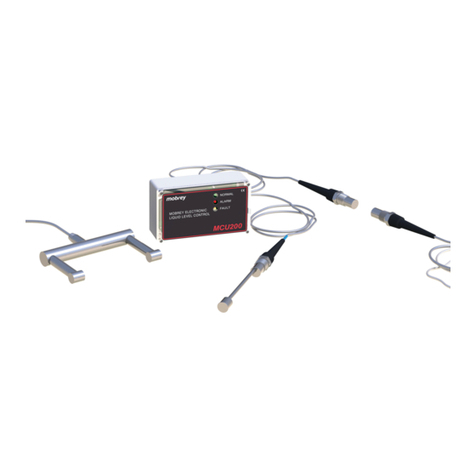
delta-mobrey
delta-mobrey Mobrey MCU200 Series Installation and operating manual
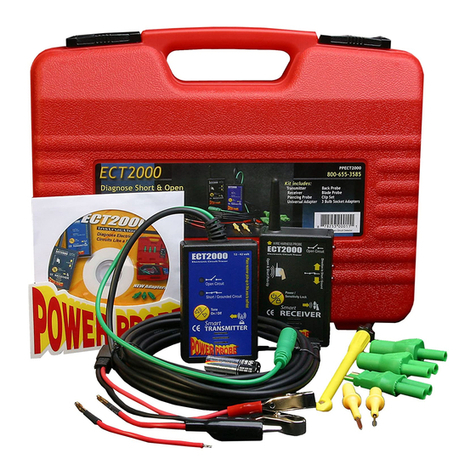
Power Probe
Power Probe power probe III ECT-2000 instruction manual

Bender
Bender COMTRAXX MK800 manual

Wetekom
Wetekom 81 93 92 instruction manual
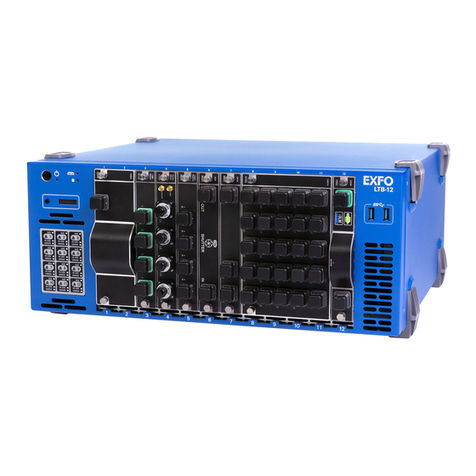
EXFO
EXFO LTB-12 Quick reference guide

Sony
Sony M-640V - Microcassette Recorder Service manual
